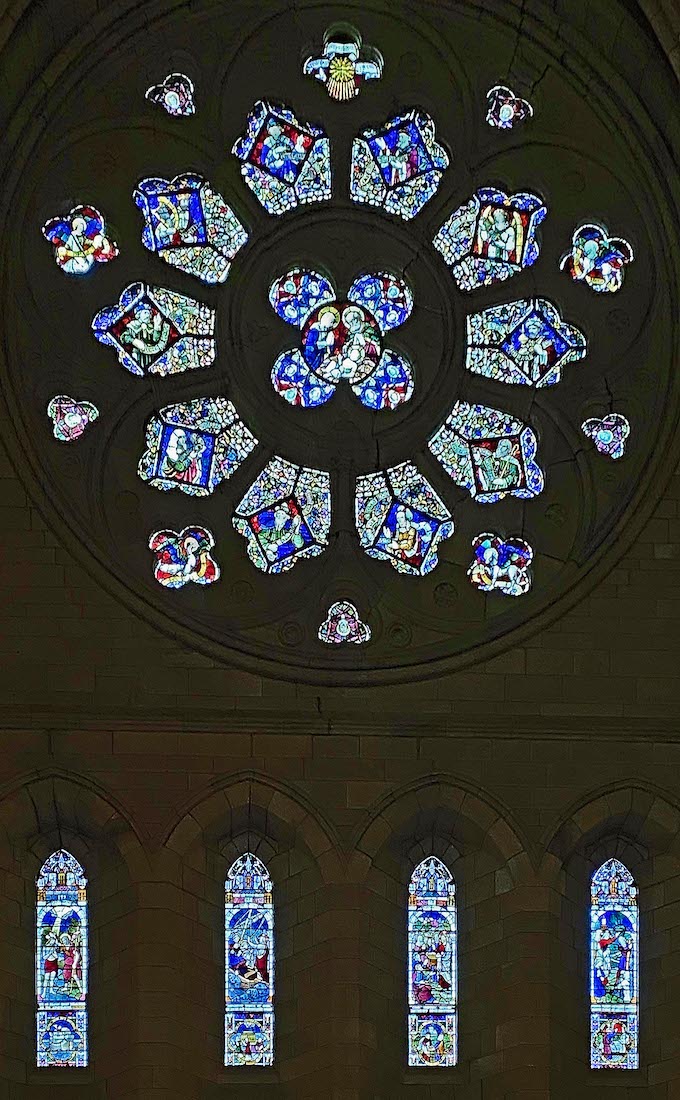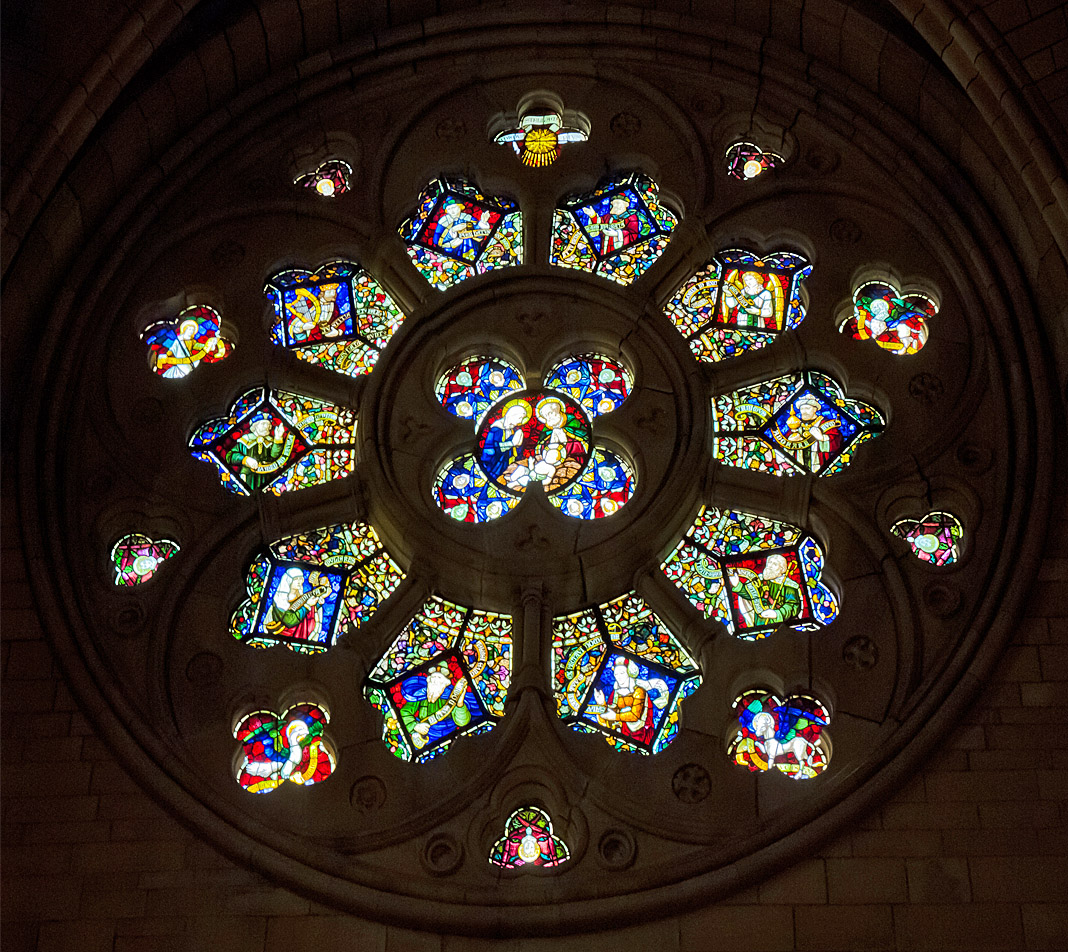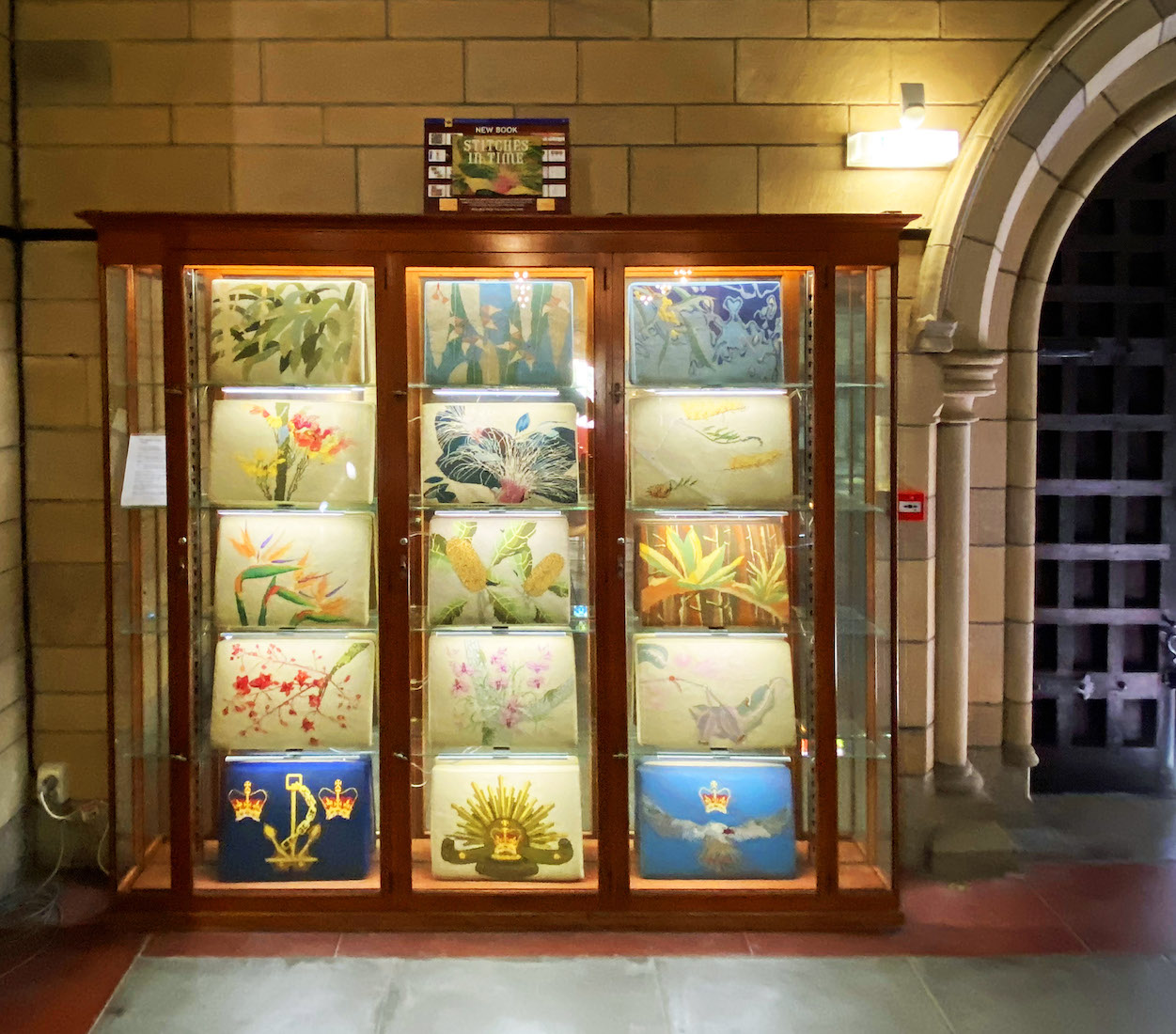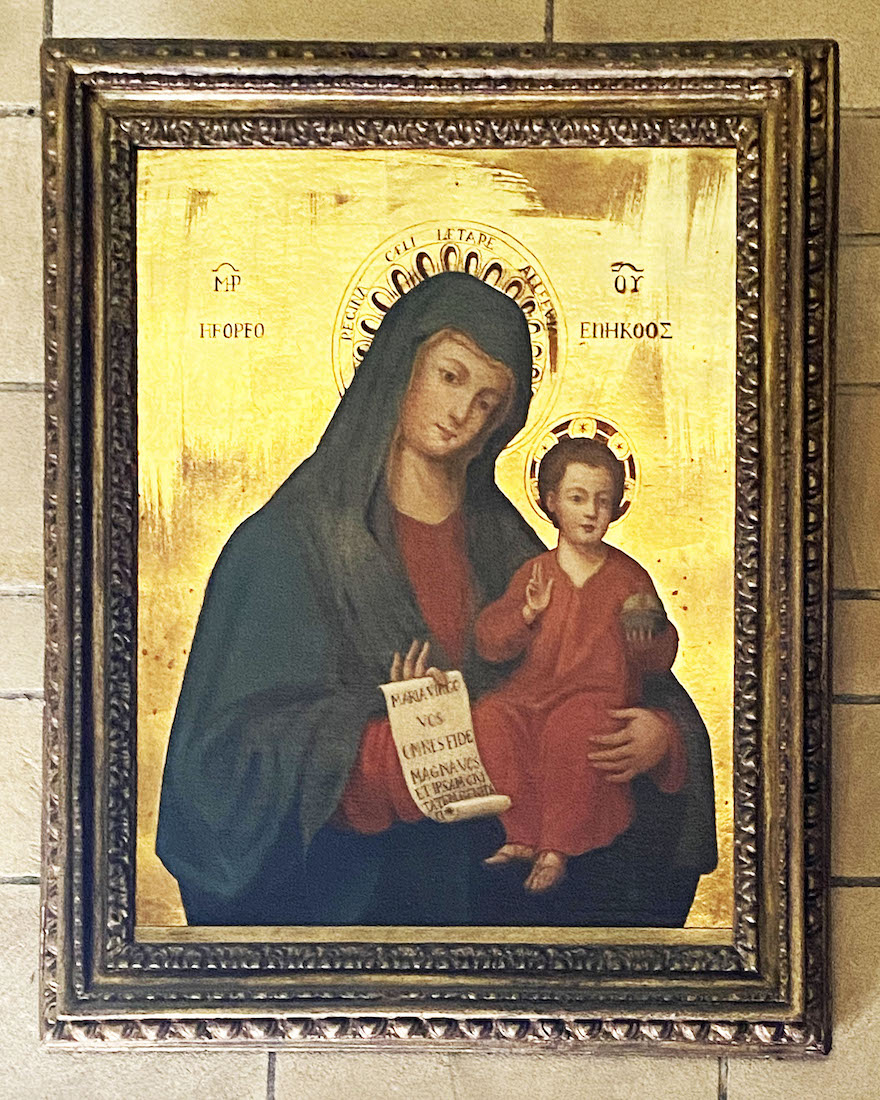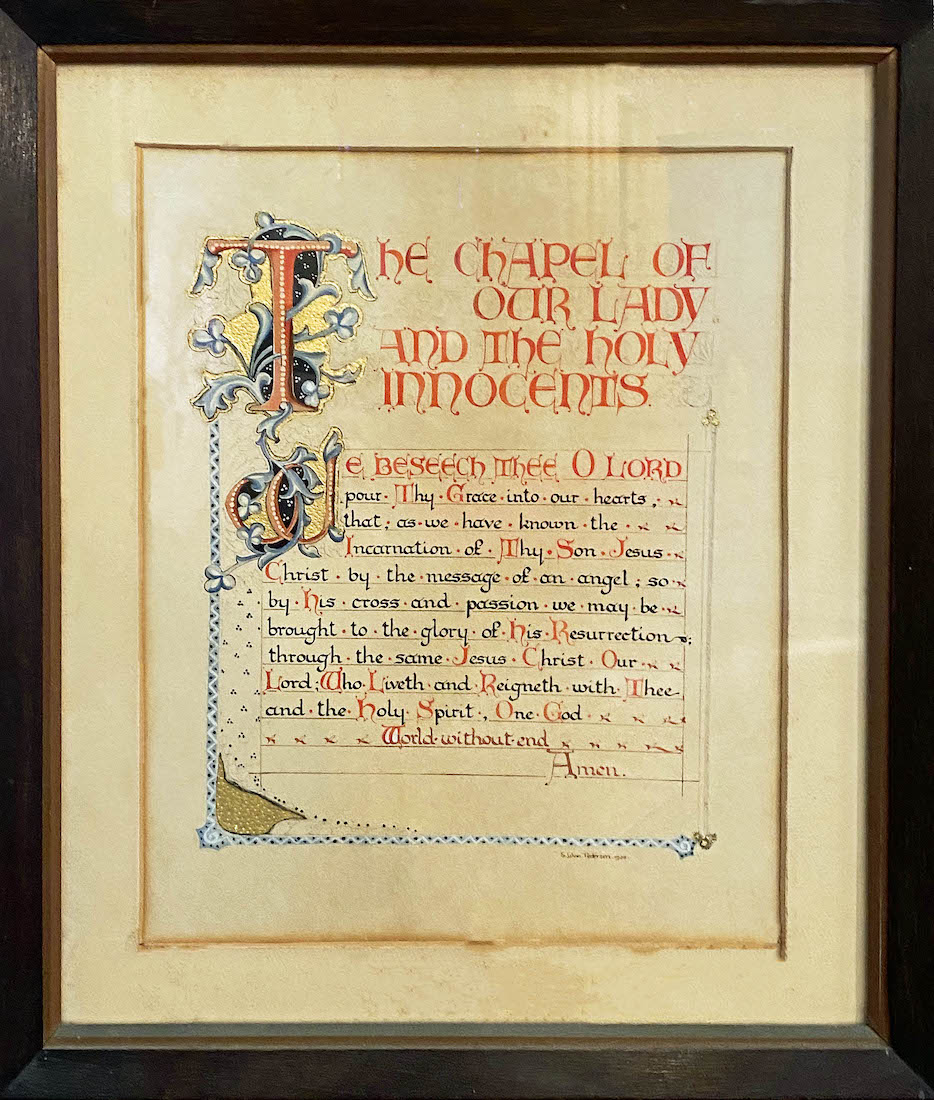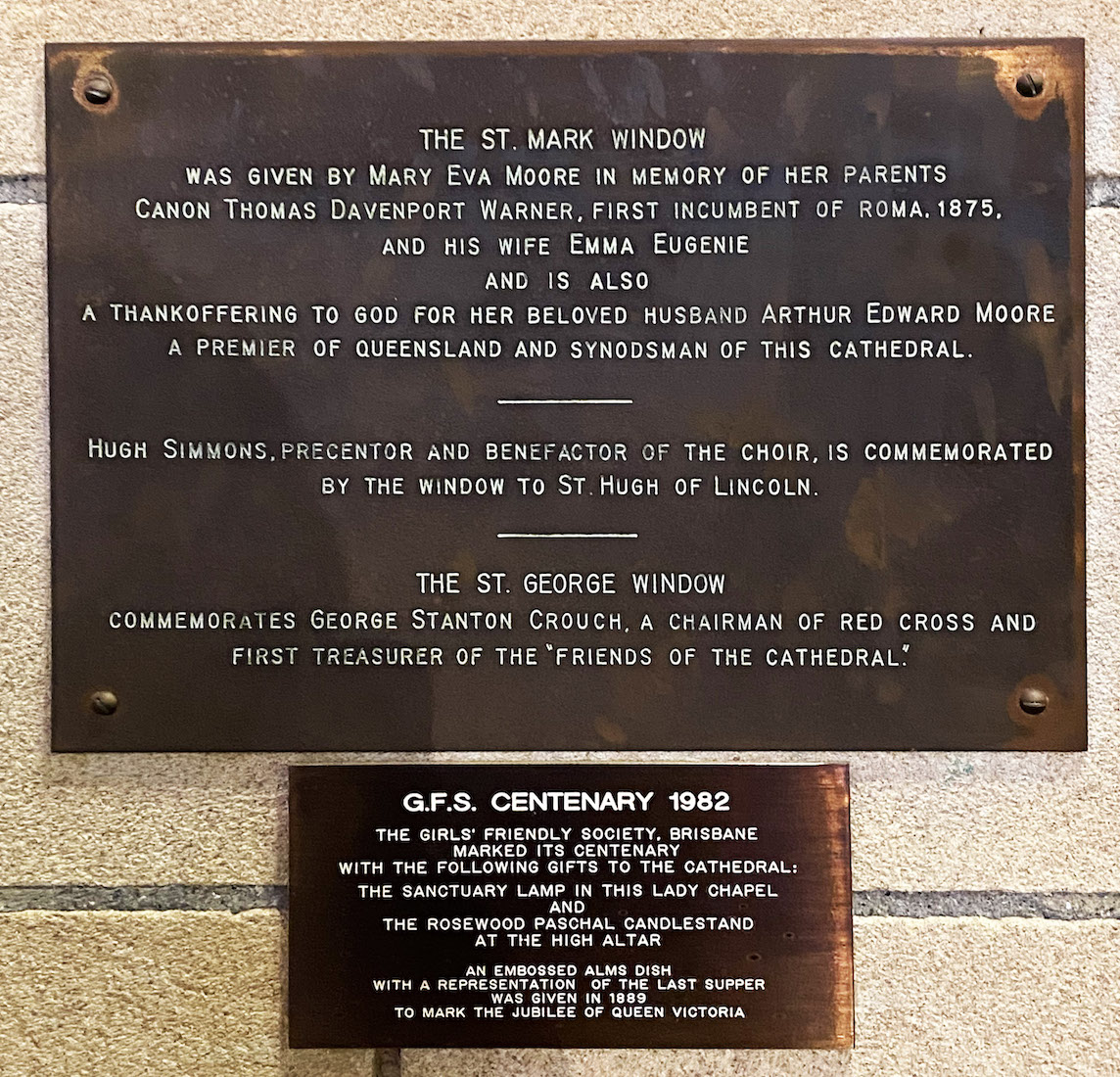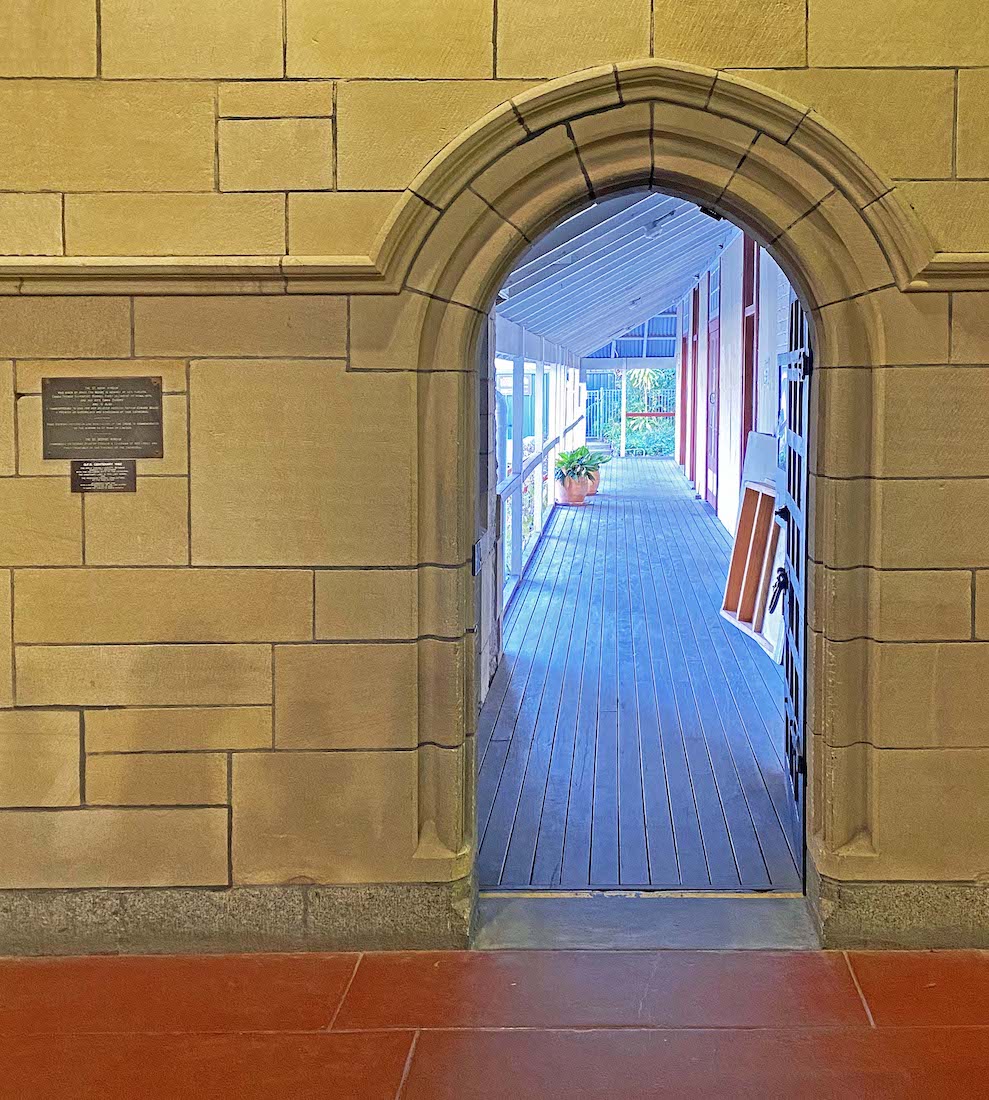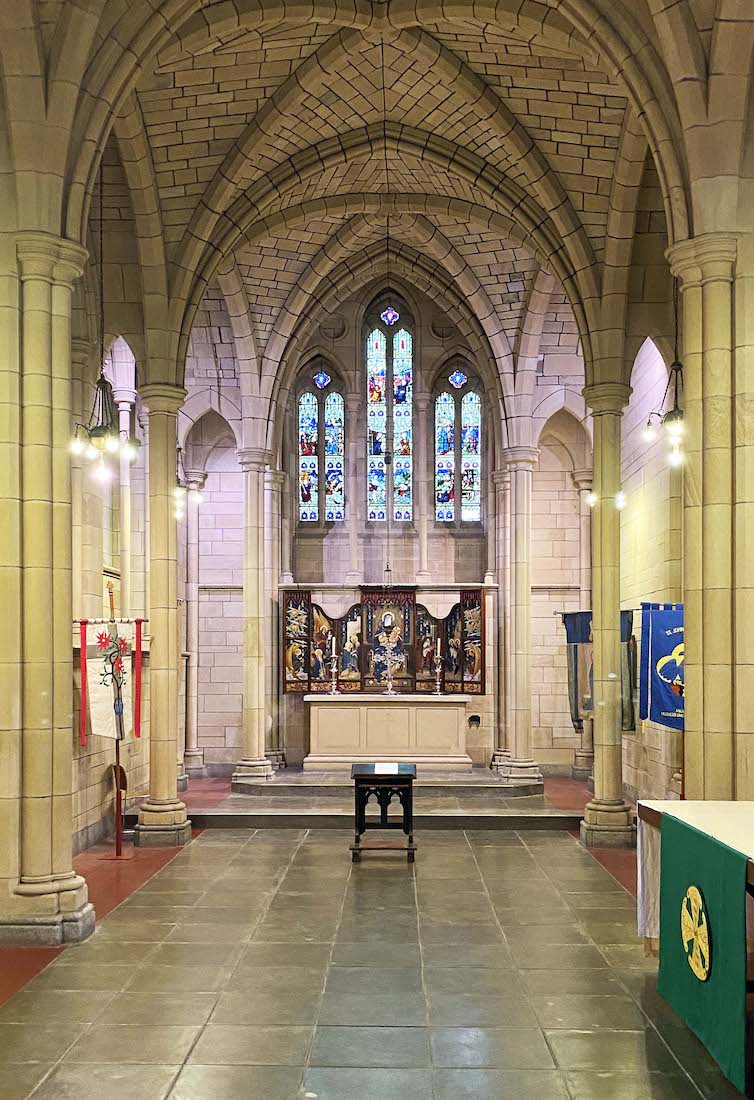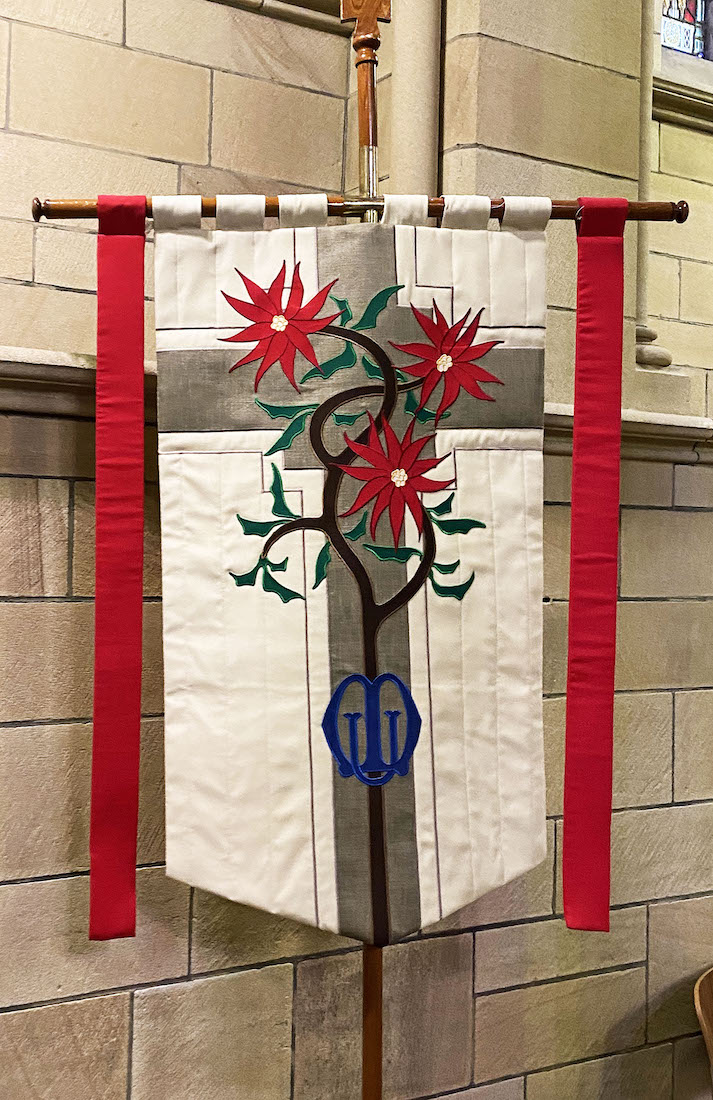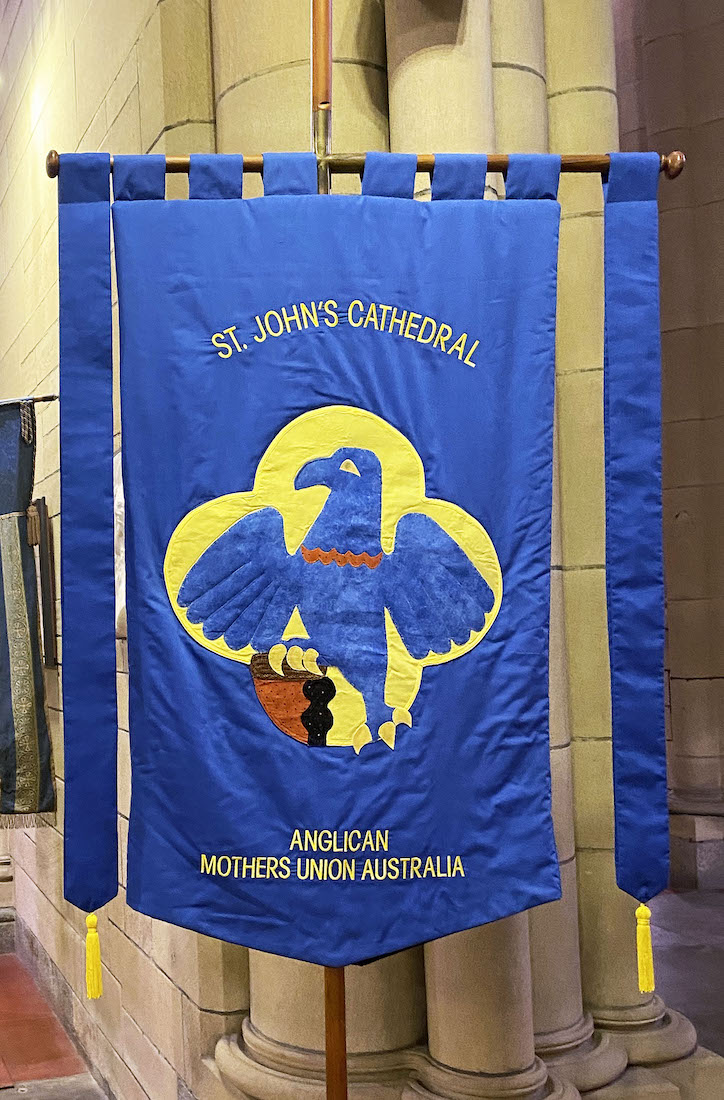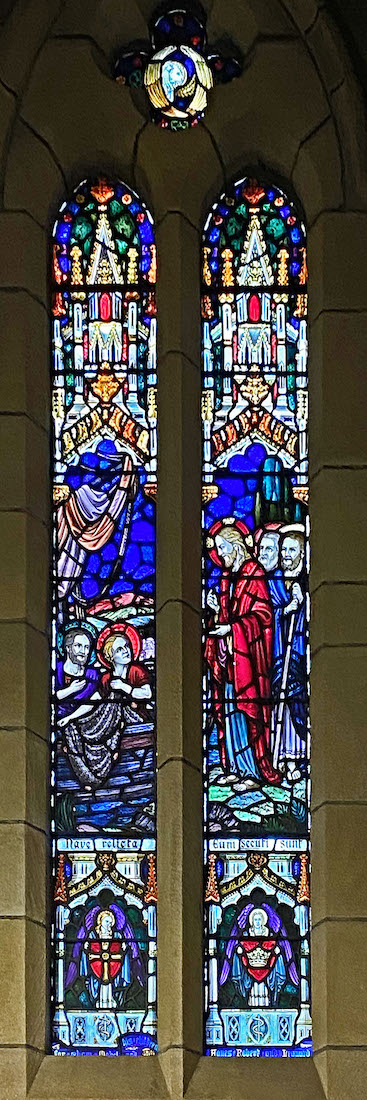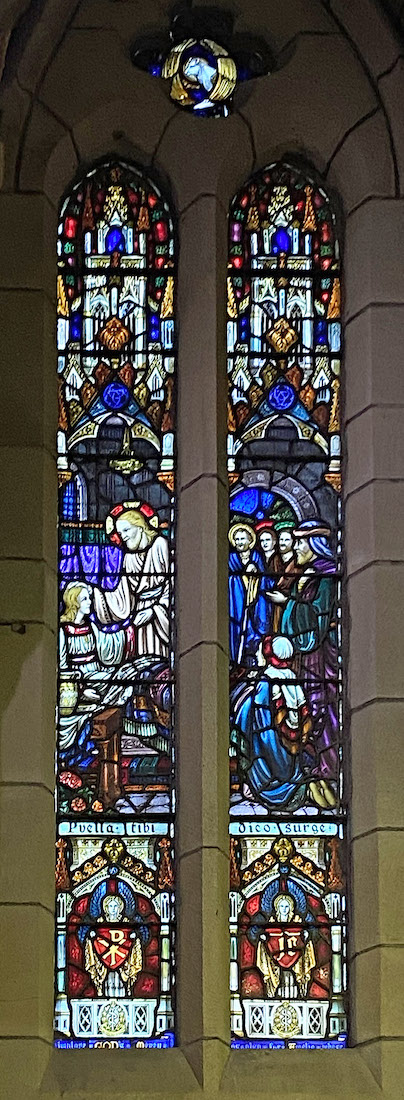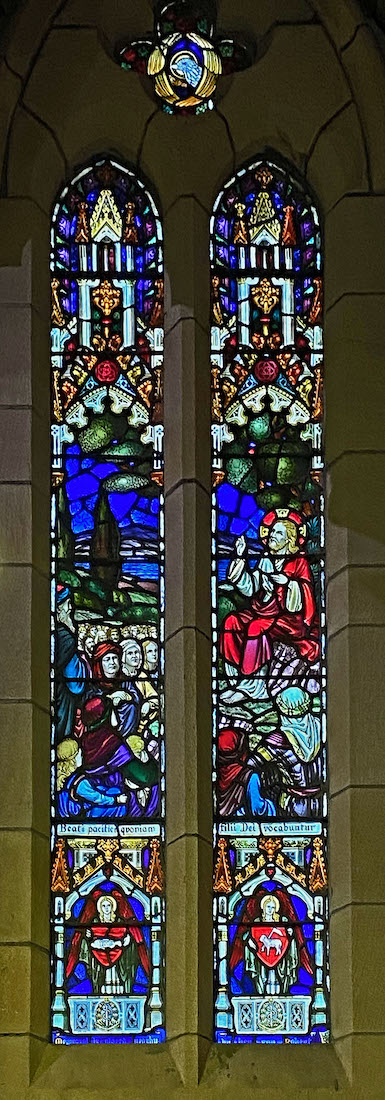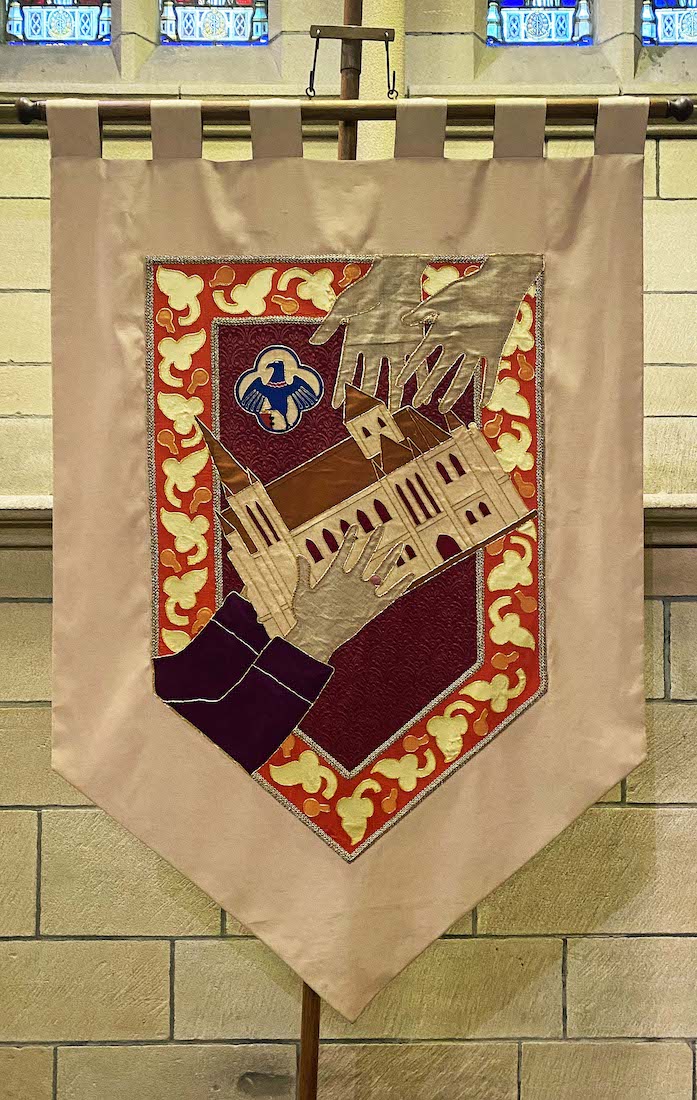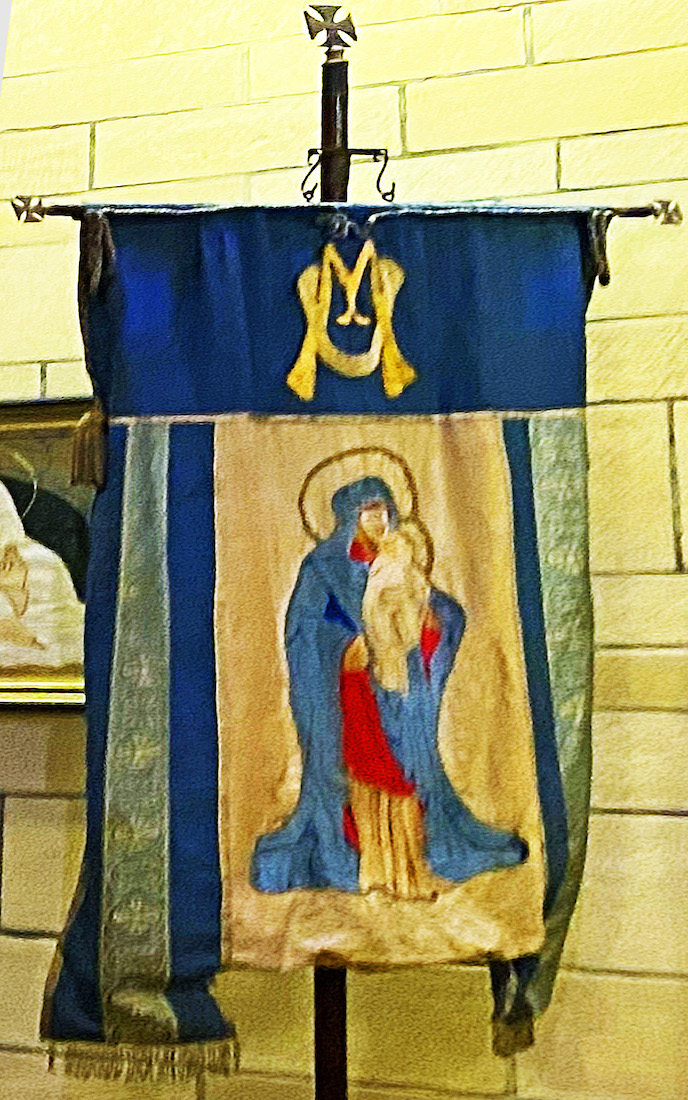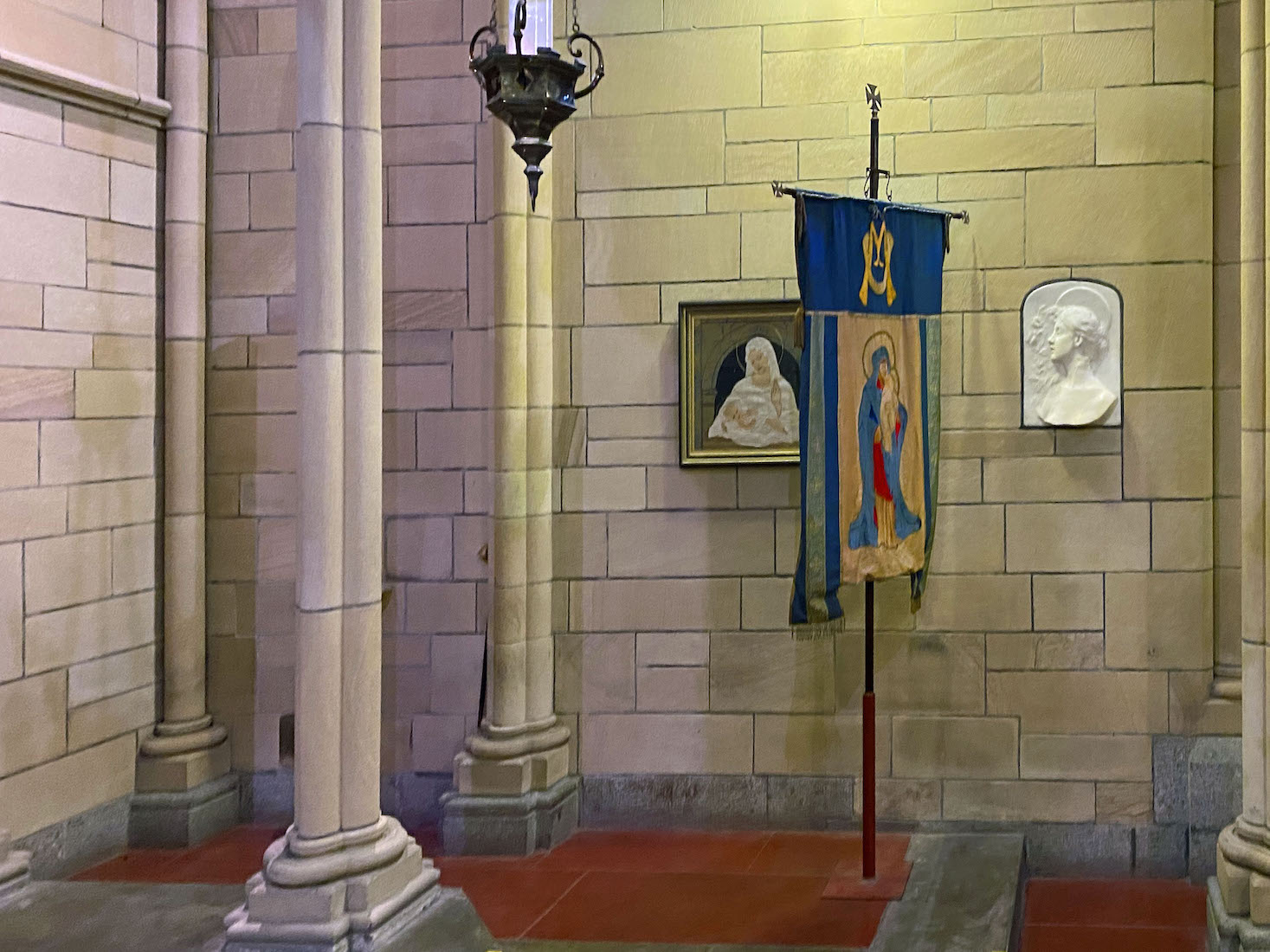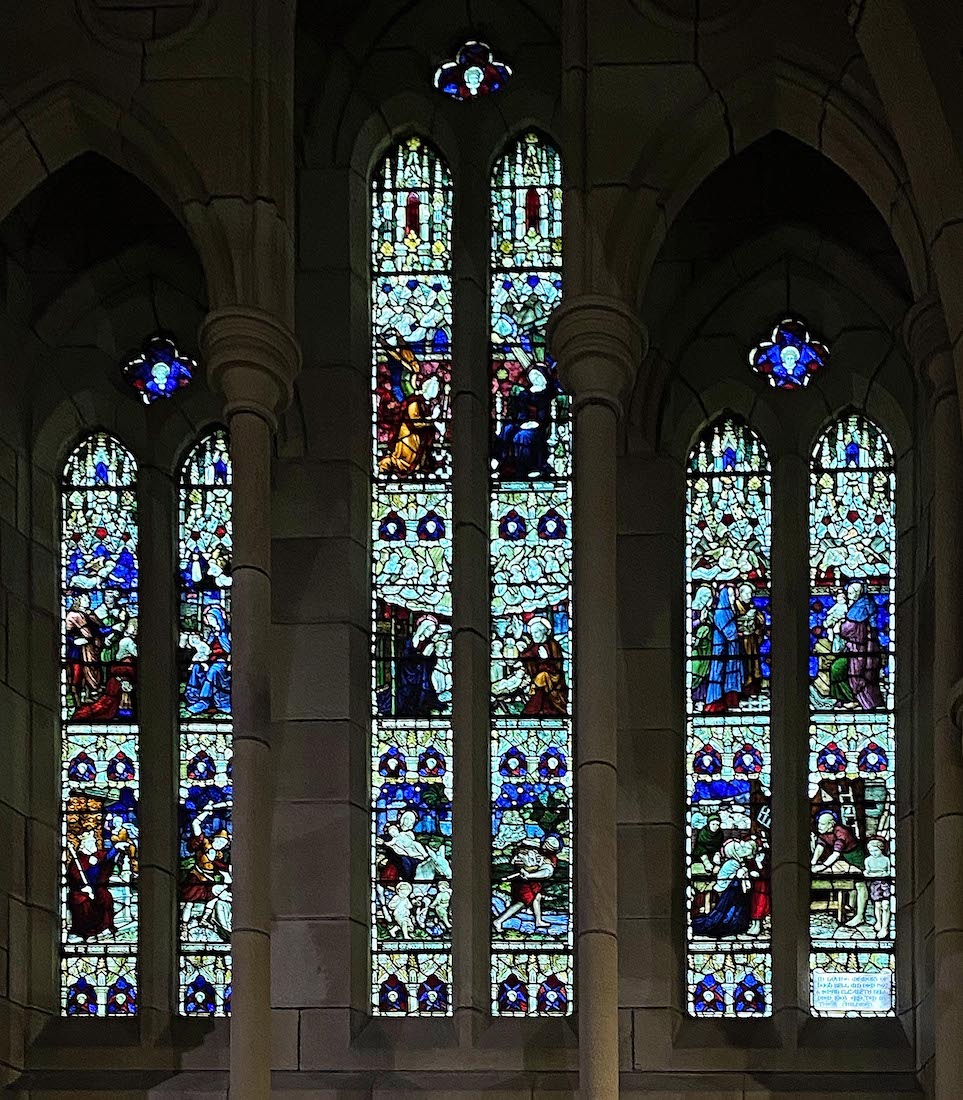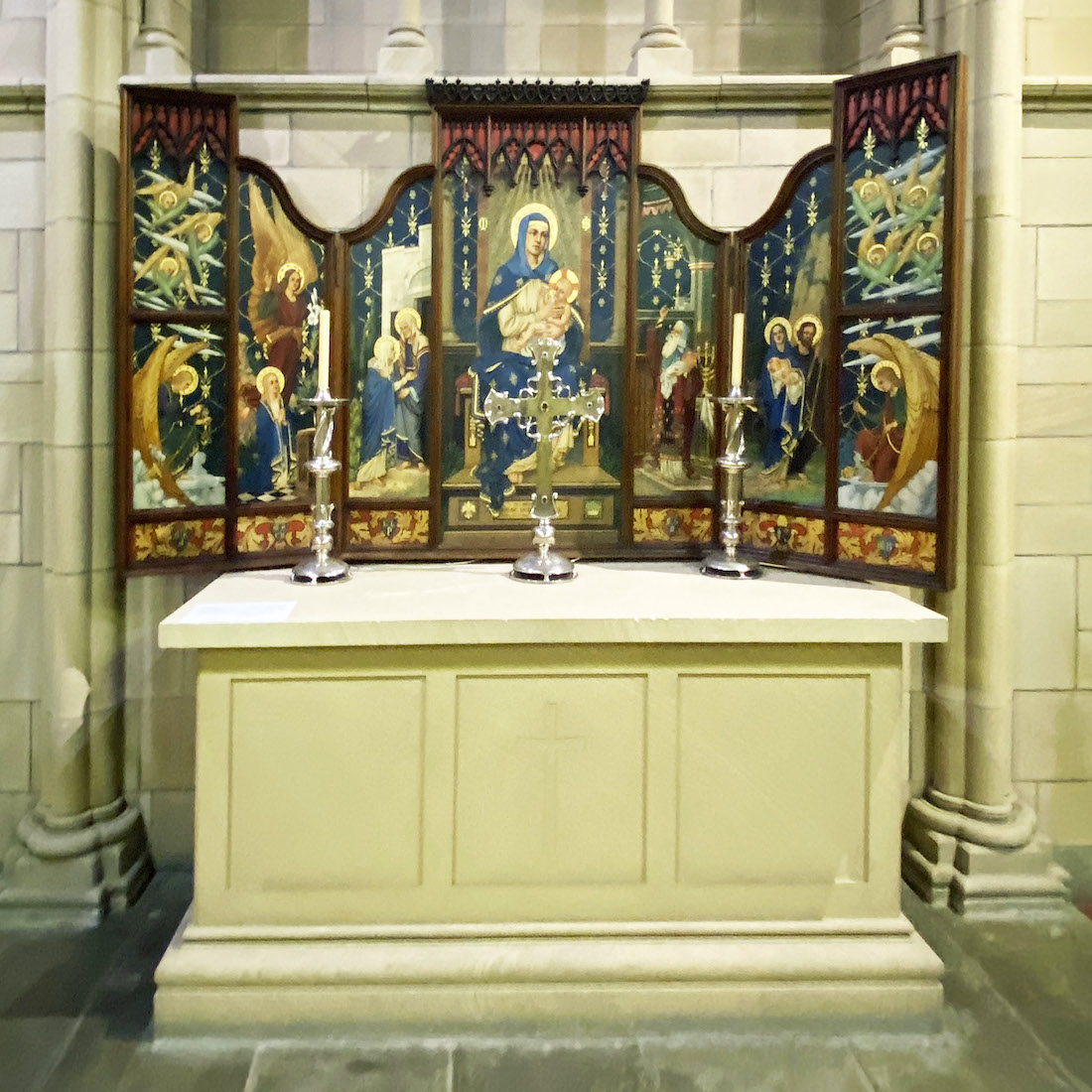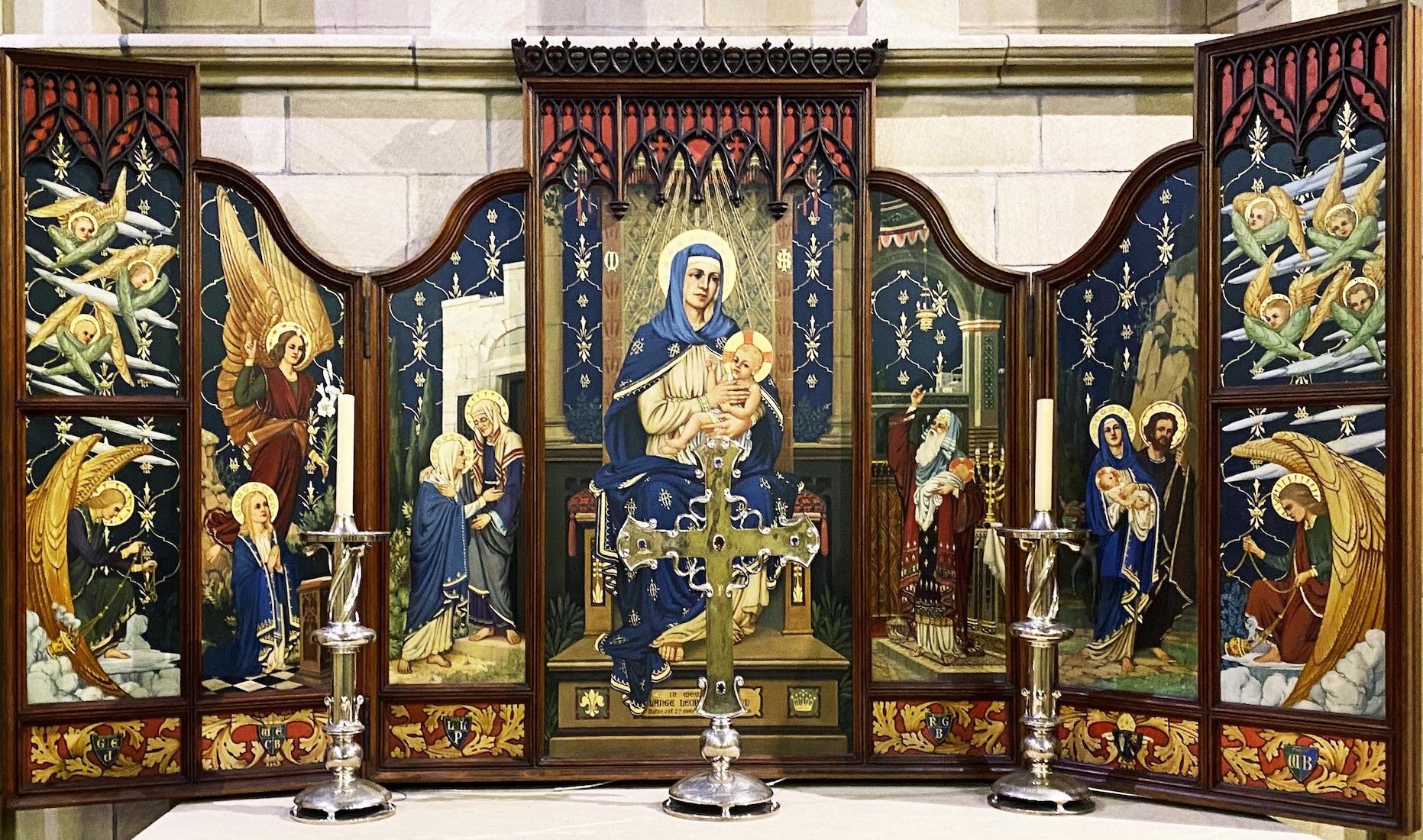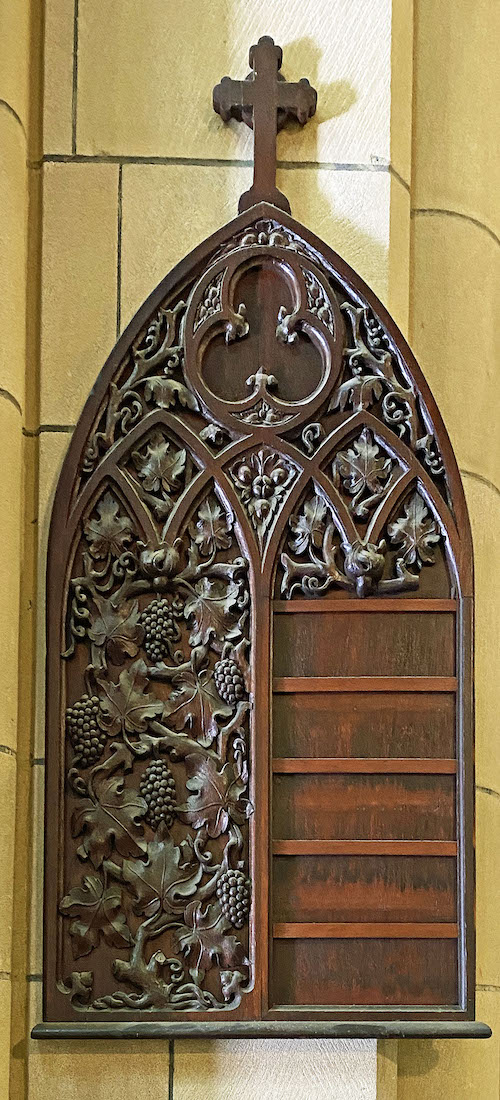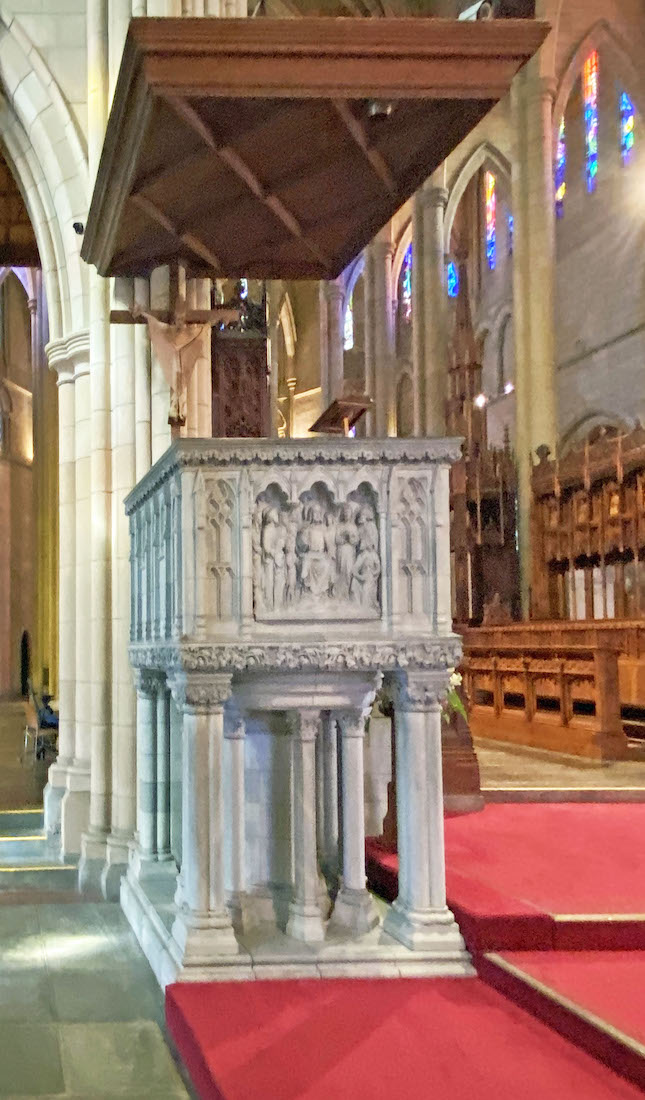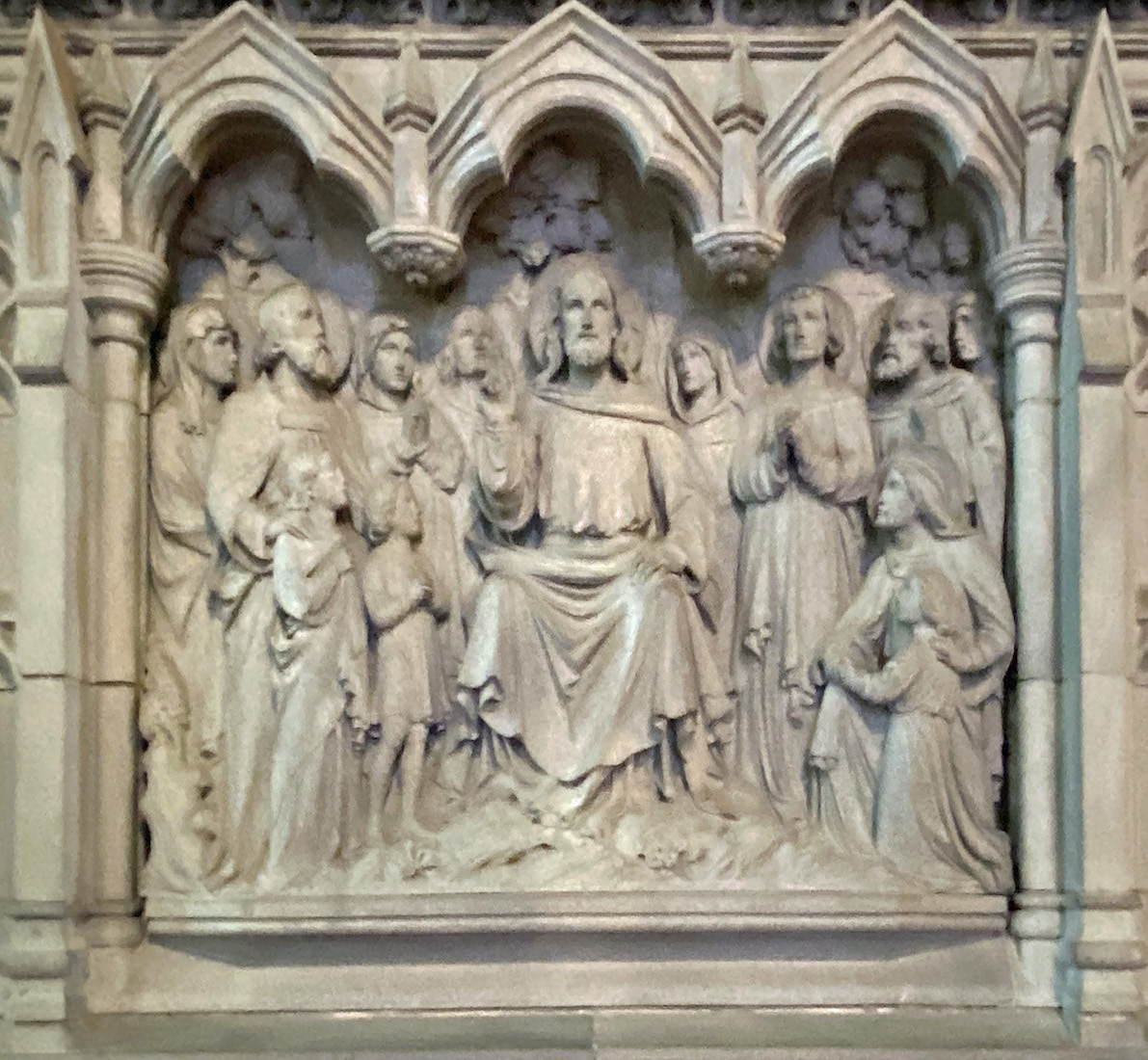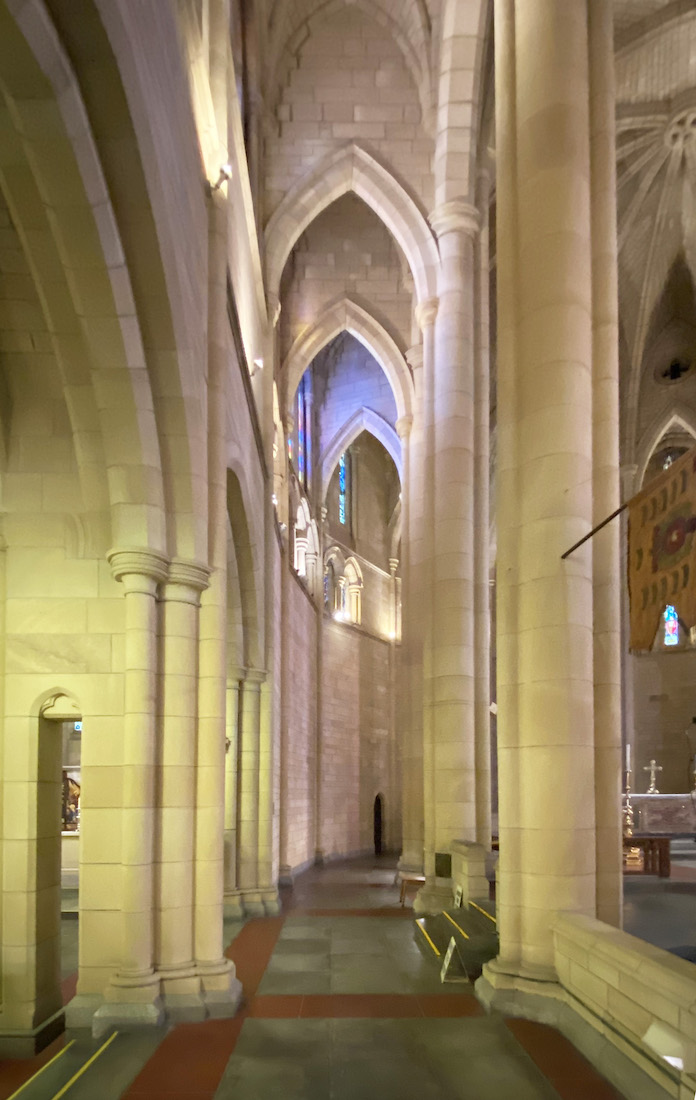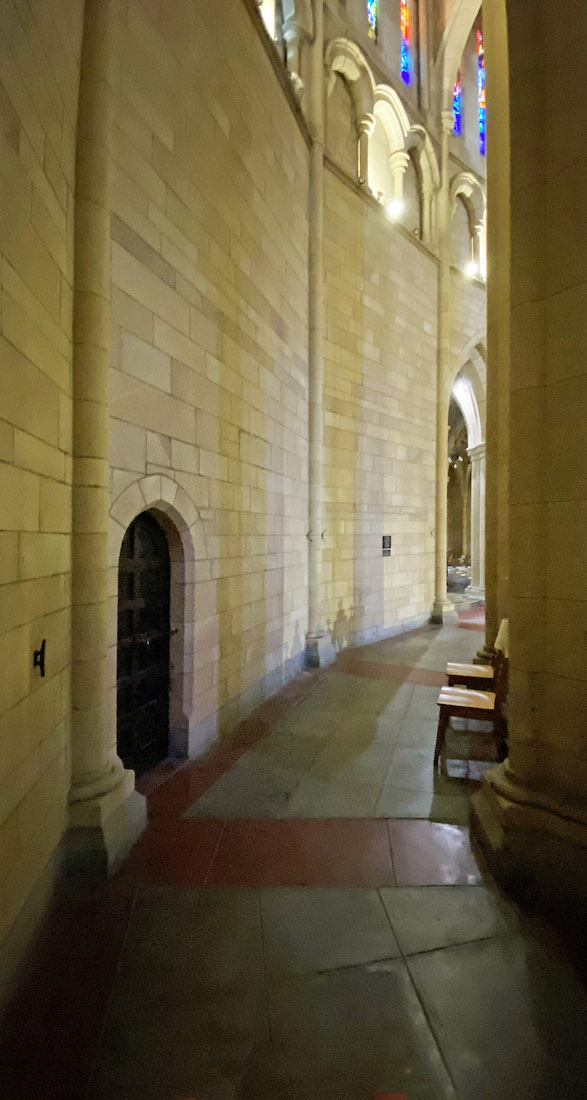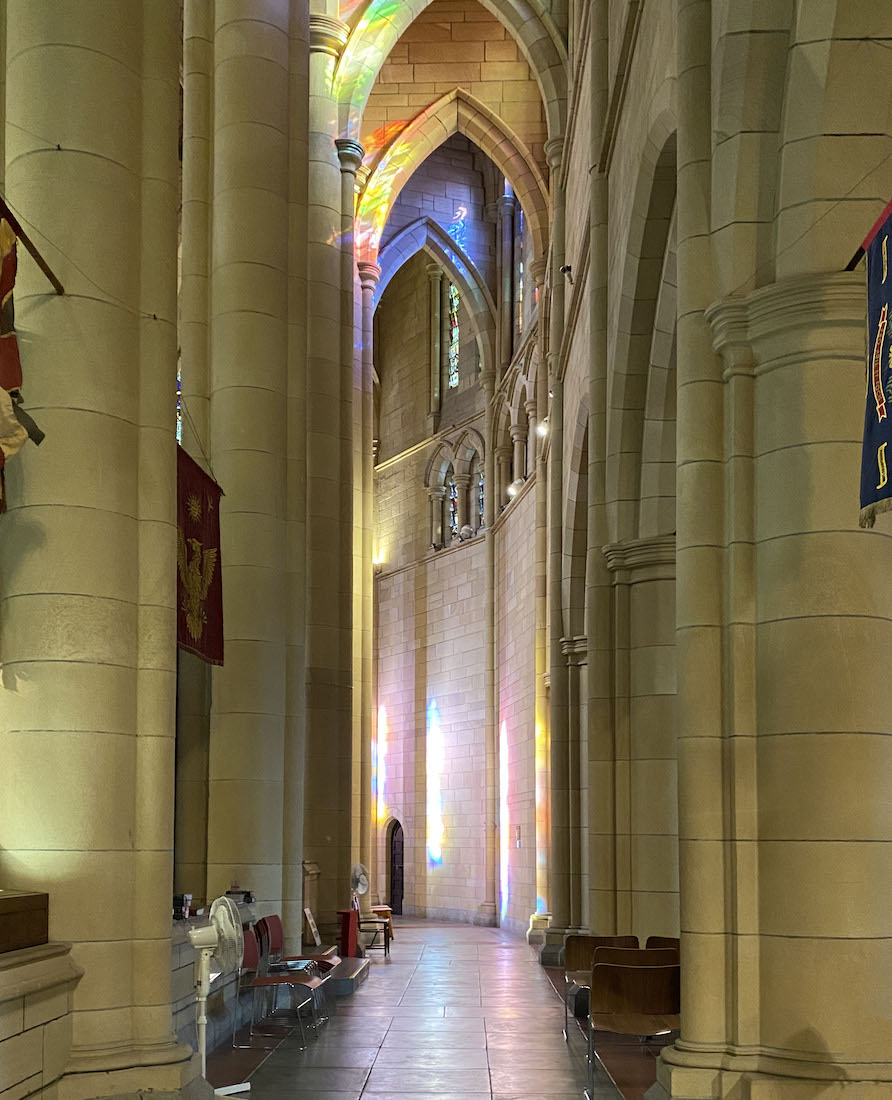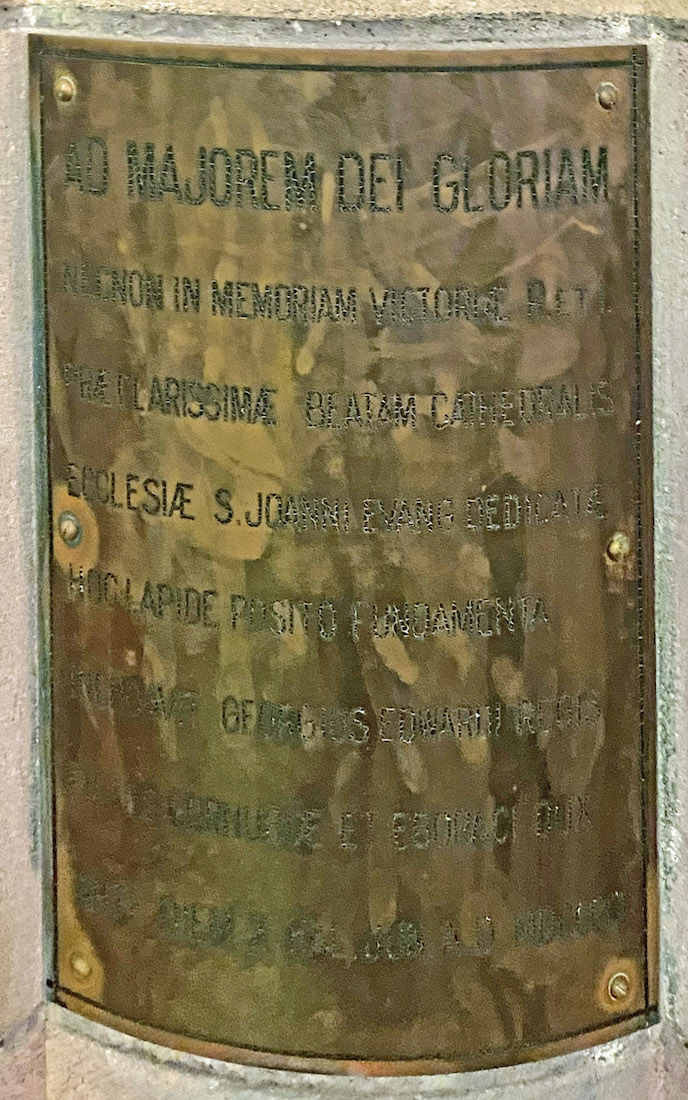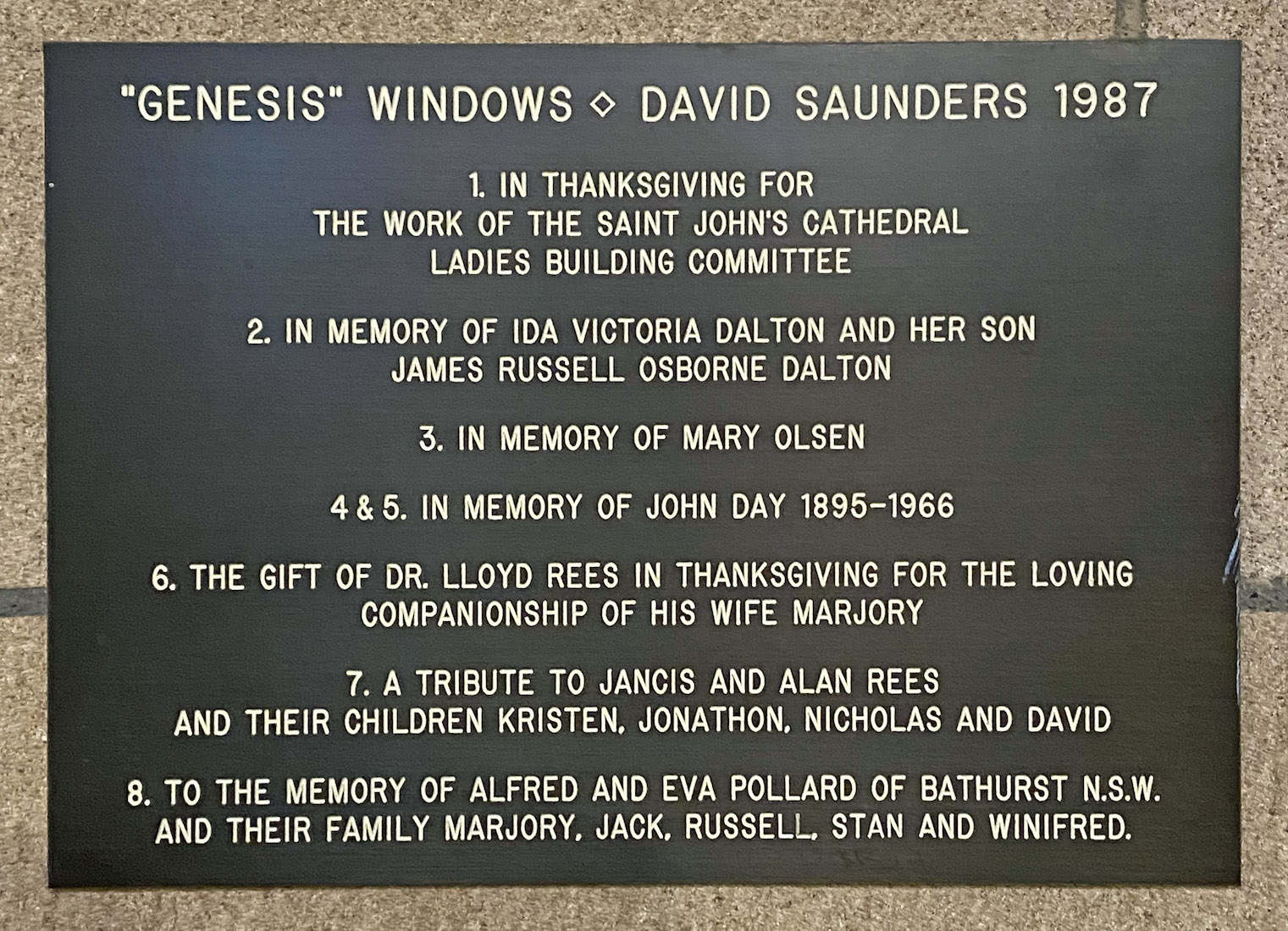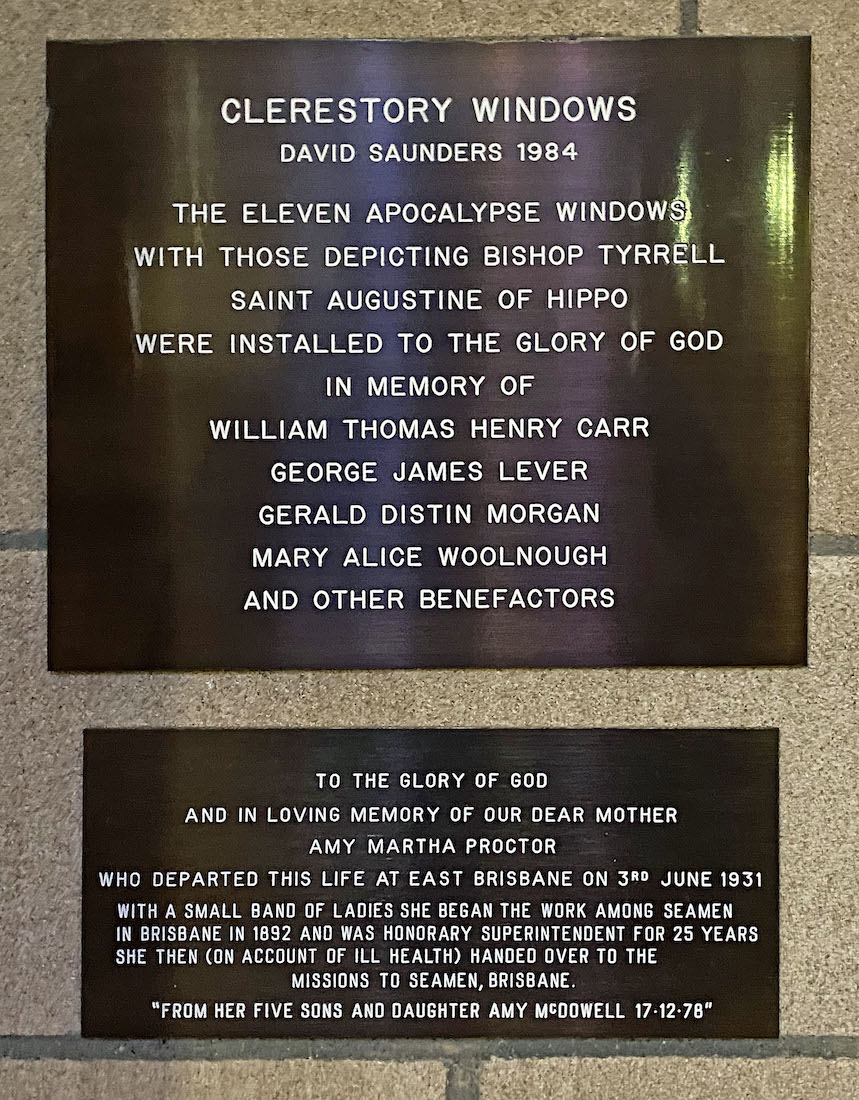41. EAST END OF THE NORTH AISLE
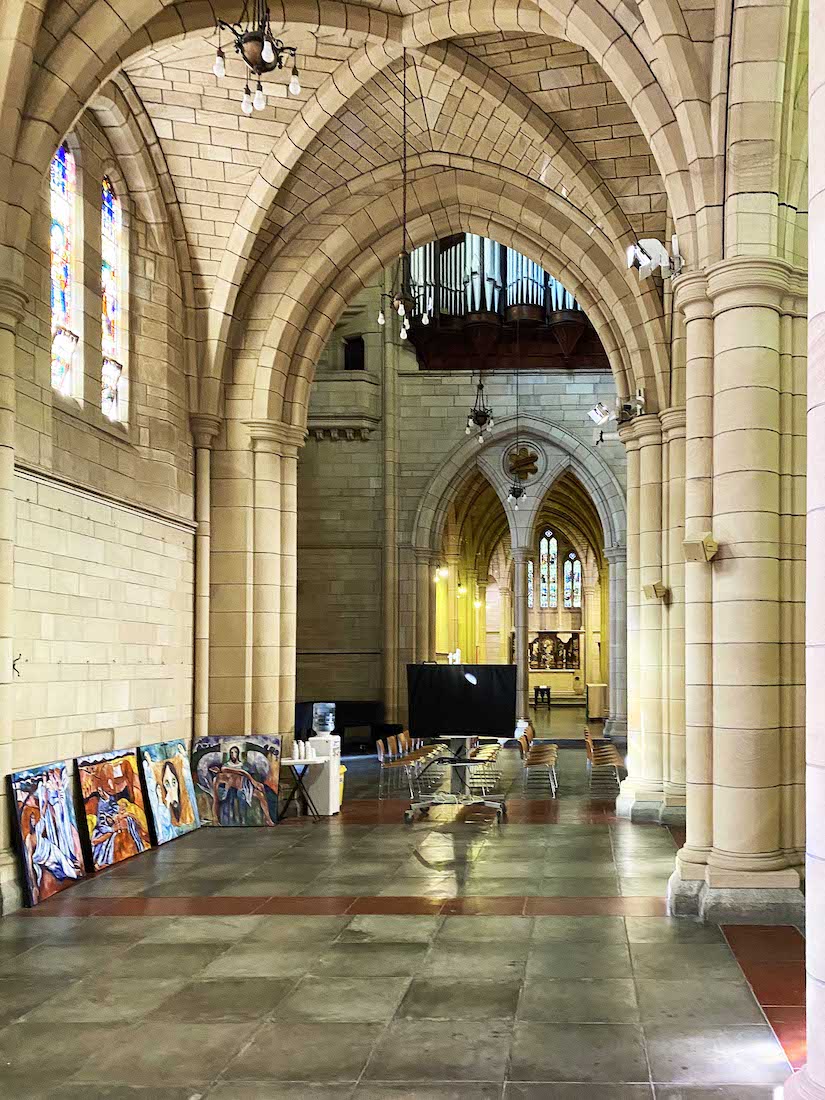
At its East end, the aisle leads to the North transept with its high stand of organ pipes. Beyond, we see the Lady Chapel. INDEX
42. NORTH TRANSEPT
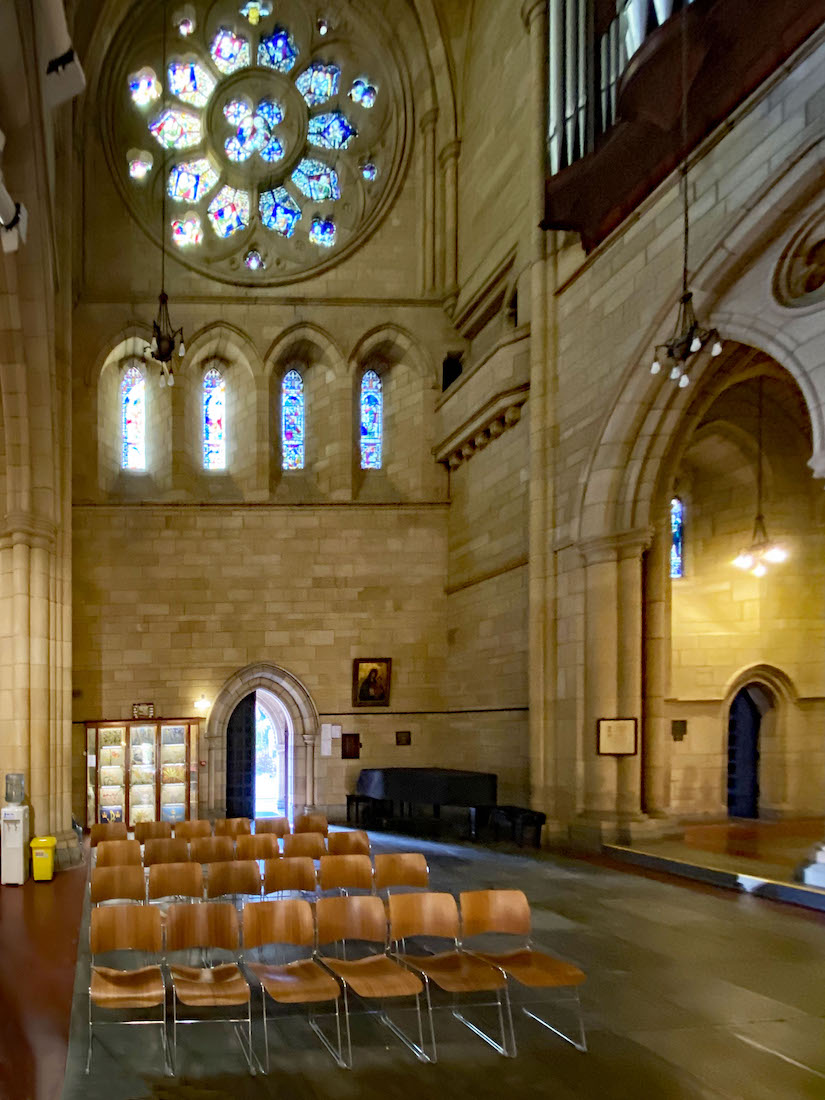

The North transept is quite shallow. On the North wall is a wheel (rose) window, with four lancet windows below. Lower down there is an interesting looking cabinet at left, and a large framed icon of Mary and Jesus at right. For future reference notice too the position of the framed text, brown plaques, door and high stained glass window just inside the Lady Chapel at right. The organ pipes shown form only a part of the organ’s pipe array.
43. NORTH TRANSEPT WINDOWS
The transept arrangement of a rose window with lancet windows below is not uncommon in cathedral design.
44. NORTH TRANSEPT WINDOW DETAILS
The wheel window was designed by Frank Pearson. The central panel shows the Nativity with Mary and Joseph watching over the baby Jesus. ••• From left the lancets show: • the baptism of Jesus with Noah’s ark below; • Jesus stilling the storm, with men carrying the ark of the covenant below; • Jesus healing the cripple with a healing example from the Book of Acts below; • the feeding of the 5000 with perhaps the gift of bread to Elisha (2 Kings 4:42-44) below. [Photo Credits: Wikimedia John Robert McPherson]
45. KNEELERS AND MADONNA
From 2014 the Cathedral pews were replaced by chairs, and the pew cushions were no longer required. A monthly display of 15 of the more than 400 cushions can be seen in the North transept, under the title ‘Stitches in Time’. •• On the other side of the transept door is a framed icon of Madonna and Child, recognizably based on the famous image ‘Our Lady of Perpetual Help’ which was a 15th century Byzantine icon.
46. TO THE LADY CHAPEL
We now leave the North transept and move across to the adjacent Lady Chapel. We pass the illuminated text shown above. The text reads: ‘The Chapel of Our Lady and the Holy Innocents. We beseech Thee O Lord pour Thy grace into our hearts, that as we have known the Incarnation of Thy Son Jesus Christ by the message of an angel, so by His cross and passion we may be brought to the glory of His resurrection through the same Jesus Christ our Lord who liveth and reigneth with Thee and the Holy Spirit, One God, world without end , Amen.’ •• The nearby plaques give information about the St Mark window and the St George window located above these plaques. There is a also an acknowledgement of gifts made by the Girls’ Friendly Society.
47. LADY CHAPEL WINDOW AND SIDE DOOR
St George and St Mark are pictured in this double lancet window. Adjacent to the brown plaques is a doorway leading through to the light-frame extension to the Cathedral.
48. LADY CHAPEL
We are now standing in the Lady Chapel. There are banners on each side, a colourful East window, and a magnificent folding reredos just behind the altar.
49. LADY CHAPEL BANNERS
These are colourful Mothers’ Union banners. Such banners are often found in the Lady Chapel of a church or cathedral – a place where prominence is given to Mary, the Mother of Jesus.
50. LADY CHAPEL SIDE WINDOWS
The four pairs of lancets in the side wall of the Lady Chapel show scenes from the life of Jesus. From the left: • Jesus teaching in the temple (‘But all who heard him were amazed’); • The early disciples following Jesus (‘Leaving their boats they followed him’; • Jesus raising Jairus’ daughter (‘I say to you girl, get up’); • Jesus teaching the crowds (‘Blessed are the peace makers for they shall be called the children of God’).
51. MORE LADY CHAPEL BANNERS
Two more banners in the Lady Chapel ... The banner at right is another Mothers’ Union banner. The interesting banner at left appears to show St John’s Cathedral being given (entrusted) to the people by God.
52. SOME LADY CHAPEL ART
Looking across to the South side of the Chapel we see two lovely works of art on the wall.
53. WORKS OF ART
At left is an appliqué by Margaret Bristow-Hughes; at right a marble bas relief by Sir Bertram Mackennal.
54. LADY CHAPEL EAST WINDOW
The side and East windows of the Lady Chapel were designed by William Bustard. The East window shows scenes from the early life of Christ: the Annunciation, the Nativity, Presentation in the Temple, Slaughter of the Innocents, Escape into Egypt, and Family life in Nazareth.
55. LADY CHAPEL ALTAR
In the Lady Chapel there is a simple altar with three front panels. A simple cross outline is set into the central panel. On the altar is a cross and two candlesticks. Of more interest is the painted triptych behind the altar – an altarpiece with two folding panels.
56. LADY CHAPEL REREDOS
This amazing triptych was painted by William Bustard to a design by Lange Leopold Powell in 1940; he was the Cathedral architect at the time. The central panel is a Nativity scene showing Mary and the baby Jesus. To the left is pictured the Annunciation and the meeting with Elizabeth. At right we see the Presentation in the Temple and the beginning of the Flight into Egypt. Cherubs and angels look on in worship at the outer edges.
57. HYMN BOARD AND PULPIT
Leaving the Lady Chapel, we enter the ambulatory, walking between an elaborately decorated hymn number board, and the pulpit dating from 1928. The carved panel at the front of the pulpit shows Jesus teaching a crowd of followers.
59. AMBULATORY II
The colourful apse windows are high up on this outer wall, and best seen from the crossing or choir areas. There are several plaques on the ambulatory walls. Notice too the Regimental Standards hanging at top left and right of the second photograph.
60. AMBULATORY PLAQUES
Near the Northern end of the ambulatory is this brass plaque indicating the laying of the foundation stone of the Cathedral in 1901 in the presence of the Duke and Duchess of York (later King George V and Queen Mary). Towards the Southern end we find these other brown plaques, one acknowledging benefactors of the 11 Apocalypse clerestory windows (1984) by David Saunders, and below, a memorial for Amy Martha Proctor.


